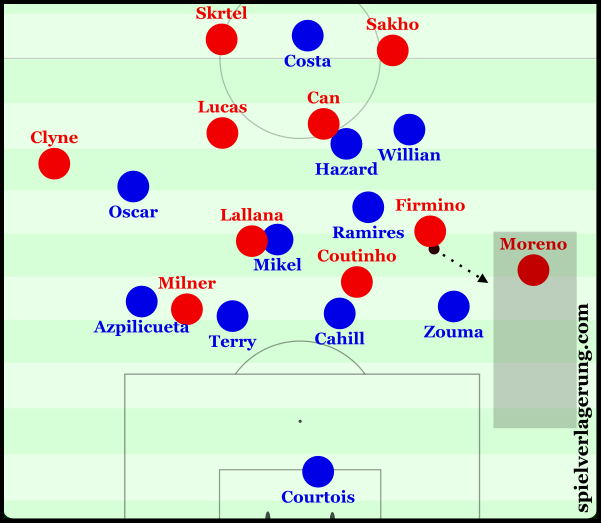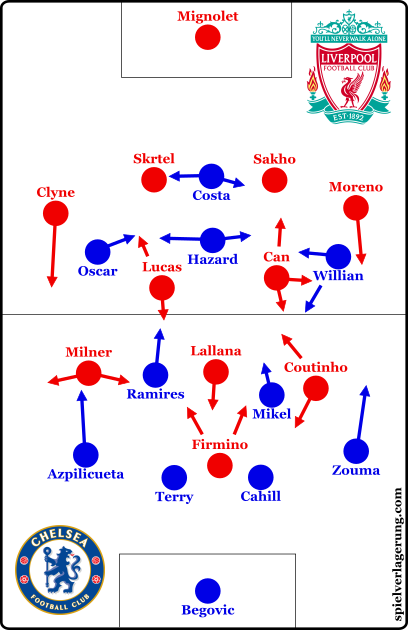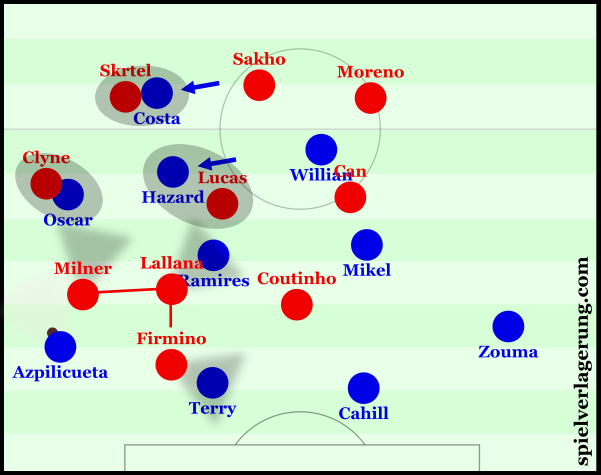Chelsea – Liverpool 1:3
Jurgen Klopp achieved his first win in the Premier League to the ever-extending misery of Jose Mourinho as Liverpool won at Stamford Bridge following a brace from Phillipe Coutinho and one from Christian Benteke.
Klopp Decides on a 4-2-3-1 whilst Oscar is Reintroduced on the Wing
For his first few games as the boss at Anfield, Jurgen Klopp has opted for a 4-3-2-1 formation with Lallana and Coutinho operating in a narrow midfield behind a lone striker. Despite a relatively similar line-up, Klopp decided to set his team in a 4-2-3-1 shape, more reminiscent of his tenure at Borussia Dortmund.
Roberto Firmino was the striker and made frequent dropping movements as expected whilst Adam Lallana was directly behind him in the 10 position. Coutinho took on the left half-space whilst Milner was more variable, fluctuating between a position in the right half-space and the touchline.
A key feature of Liverpool’s attacks was the partnership between Lallana and Firmino, particularly the Brazilian’s variable movements. During many movements in the first half you could suggest Liverpool were playing without a striker and often looked like a 4-2-4 with Firmino coming into the midfield. In other moments however, the two central attackers rotated positions to some success.
Although the movements between Can and Lucas were rather typical of a double 6 partnership, it was interesting to see more expansive runs from Lucas. In matches so far, the Brazilian has played a restricted role and commonly dropped deeper however against Chelsea, he could be seen moving ahead of the ball quite a bit. This is particularly intriguing being away from home in a potentially tricky game, yet is perhaps an indicator to how Chelsea are viewed currently as well as Klopp’s positive attitude. Another possible reasoning could be Hazard’s central role as the Belgian is not known for his defensive efforts, yet this still leaves a counter-attacking threat.
Mourinho stuck with his 4-2-3-1 formation yet made some changes to the selection. An under-performing Fabregas only made the bench as he was beaten by a double 6 of Mikel and Ramires. Although the Brazilian gave his side the lead early on, there was a distinct lack of playmaking ability from the midfield as Chelsea struggled to create throughout the match.
Oscar was brought back into the squad but was interestingly elected to play in a position on the left of the ‘3’. He frequently moved back towards the centre whilst Hazard made movements to the left flank in particular, whilst he permanently returned to a central role once his Belgian teammate was replaced by Kenedy in the 60th minute.
Chelsea’s Passivity and Weak Counter-Attacking
Mournho’s side caused themselves some issues by playing a passive defensive game. During Liverpool’s build-up game, they would only press with intensity once the ball reached around the half-way line – up until that point, no pressure was made on the centre-backs. This was potentially influenced by the early goal for Mourinho’s team as they reverted back to old ways and sat without enough pressure.
It was particularly an issue in the half-space, as they lacked a defensively-strong 10 with Hazard there.
Without much pressure against them, the Liverpool centre-backs (particularly Sakho), had more freedom to play penetrative passes towards the centre. Spaces were commonly opened through the flexible movements across the trio of Coutinho, Lallana and Firmino which was strong against the man-marking of Chelsea’s midfield. Although the orientation of Liverpool’s possession game was maladaptive, they created some decent situations during these moments but simply didn’t capitalise on it through a weak wing-focus.
It should be noted that this may have been more successful against a less-aggressive Liverpool under Rodgers, however the increased verticality which Klopp has introduced was a strong counter to Chelsea’s organisation. His attacking structure occupied more (and better!) passing lanes which not only improved Liverpool’s access when moving the ball into higher positions, but benefited the counterpressing following the turnover.
Upon regaining possession of the ball, Chelsea looked to add to their lead through counter-attacks. Hazard offered potential centrally whilst Costa would shift the ball-near half-space which was presumably to exploit Liverpool’s highly-positioned full-backs whilst he dragged a centre-back out with him in the process.
However, counter-attacks in such positions lacked threat for the most part due to the spaces used. The wings offered little variabilty and often counters struggled to even start as Chelsea struggled to find Costa initially whilst the striker had issues in bringing in other attackers due to his position near the touchline.
Liverpool Pressing
The development of Liverpool’s pressing game will be under much scrutiny following Klopp’s appointment and the side put in a reasonable performance in an aggressive showing. They showed key signs of improvement since the managerial change looked strong as they will soon (if not already) become the best in the league for this defensive aspect. It may be unlikely that Klopp will ever have Liverpool reach the pressing ability of his Dortmund though it will not take long for them to be comfortably ahead of any other Premier League competition.
Again they were strong at forcing the ball into wide areas during Chelsea’s build-up to trap them, with their shift in intensity particularly impressive. This was more commonly done down Liverpool’s right, perhaps to make more of Milner’s defensive ability as opposed to a weaker Coutinho. Similar features remained from their 4-3-2-1, such as the actions of the ball-near winger in pressing the ball-carrier as they press vertically.
Like in the match against Southampton, this may have been a precaution against wider developments – both Hazard and Costa shifted towards the touchline during wider developments which gave them slightly more potential (yet still rather weak). Despite this, the pressing was still nicely stable and effective (more-so than against Southampton) pressing down the wings which disrupted the build-up of Chelsea well.
With the ball-near winger, Lallana and Firmino/Benteke, Liverpool were able to form a competent press across the 3 major angles. In co-ordination with the man-marking by the full-back and nearer midfielders, they could isolate the ball well.
Wing-Orientation Issue for Liverpool’s Possession Game
One downside of Liverpool’s performance was their focus on wing-play in possession. Despite making decent openings in the centre of the pitch, they moved the ball towards the touchline not only far too frequently, but also too early in the play.

A moment from the 32nd minute, Firmino unnecessarily passes to Moreno instead of a centrally-focused attack,
As I mentioned when talking of Chelsea’s passivity, Liverpool were able to break through the first line of pressure quite commonly in a central position, yet for some reason they quickly wanted to shift the ball over to wider spaces.
This resulted in limited options and variability in the final third as the access of space weakened amongst other strategical issues associated with wider positions. When they looked to bring the ball back inside, it was usually too late in the attack and could easily be restricted by Chelsea. It was not helped by relatively weak structures – particularly down the right where Milner and Clyne would often be positioned in a straight vertical line.
In comparison, Chelsea were more focused on breaking through the centre yet struggled to do so against a Liverpool defense which controlled space well. They were more patient and would circulate the ball horizontally in attempt to open up a lane inside yet these opportunities were quite rare and not always taken advantage of.
I expect that this will be something which Klopp will want to address thoroughly in training as it seemingly stems from the orientation on an individual-level which Rodgers developed. Because of this it may be a while for clear improvements to be seen though the impact will be significant. Meanwhile, alternative issues such as poor structures and attacking strategies are typically-English and likely to improve as Klopp takes over what Rodgers left behind at Melwood.
Later Developments
Probably encouraged by their equalizer late into added time of the first half, Liverpool came out following the interval with increased aggression. They attacked with greater impetus which was probably most evident in their pressing, both during developed Chelsea possession and transitions which benefited from a greater intensity. This helped to sway the momentum further and Klopp’s side developed a better control of the match as the latter 45 minutes progressed. The German manager emphasised this in his first substitution which at 1-1 he replaced Milner with Benteke. Through doing this, he created a more attacking-minded ‘3-1’ whilst Firmino dropped into a central position which in-turn shifted Lallana out to the right whilst Coutinho maintained his half-left role.
Once they took the lead and then more-so after the third, Liverpool’s possession game became more stability-oriented as they saw out the rest of the match with composure. During their build-up they brought more players closer to the ball for increased-resistance against the Chelsea press, whilst were more patient and less vertical in their passing.
Conclusion
We saw yet another weak performance from Chelsea where the usual issues were their downfall. Again key players failed to deliver even competent performances whilst their typical lack of adequate pressure brings weakness in their defensive game. On the flipside, Klopp will undoubtedly be delighted to register his first Premier League win at Stamford Bridge. His side were not great – just superior as there are still clear problems to amend, albeit amongst some positives.



2 Kommentare Alle anzeigen
Andre November 4, 2015 um 11:11 pm
It’s funny how Chelsea’s awful pressing (on the rare occasions they even attempt it) may very well be the main reason behind their defensive AND offensive weaknesses.
Jojo November 2, 2015 um 8:41 am
As I am not watching BPL matches (no time), it’s nice to have some analysis like this.
Thanks a lot.